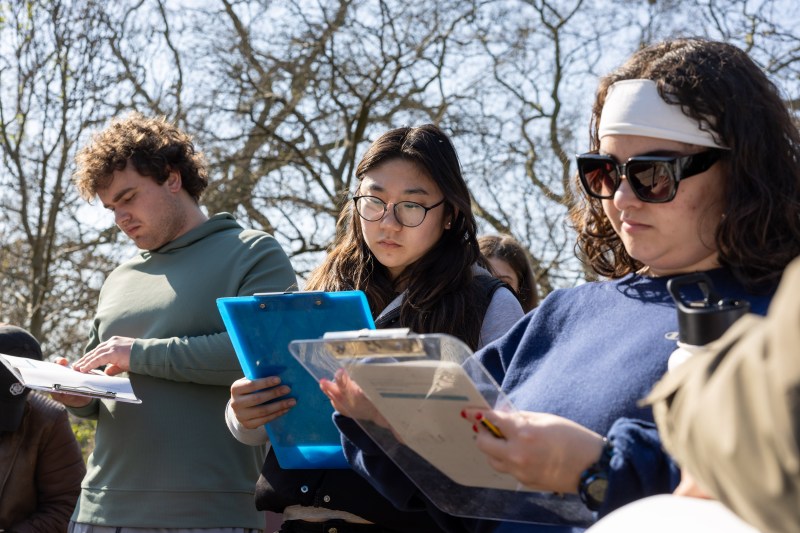Northeastern students uncover caddisflies, newts and nymphs in ecological survey of London’s Hyde Park
Uri Weill, assistant professor in biology at Northeastern University in London, said the hands-on research would provide insight into the health of the ecosystem in one of the city’s “most vital green spaces.”

LONDON — The wide open space of Hyde Park is a focal point for London’s 9 million inhabitants.
Its 350 acres — seven times the size of Boston Common — host 2.5 million people annually for the Winter Wonderland Christmas market, while 400,000 music fans flock to summer concerts in the park with the likes of Adele and the Eagles headlining.
But year-round the park, the fourth largest of London’s Royal Parks, is home to thousands of other smaller species, acting as an ecological haven for wildlife in the bustling metropolis.
About 120 students taking general biology at Northeastern University in London went to discover these creatures and plants living in the green spaces and waterways of Hyde Park during March and April site visits to undertake ecological surveys.
Hailey Homonoff’s first dip into the Hyde Park Learning Center’s pond proved a lucky one as she scooped up a newt in her net, much to the delight of her fellow classmates.
The pharmaceutical sciences major said she “definitely appreciated the real-world experience” of learning outside the classroom. “I think that’s the best way to learn,” she says. “Looking and interacting with organisms, it puts what I learned in lectures into real-life context.”





The swarming high-end shopping districts of Knightbridge, Kensington and Oxford Street lie at the perimeter of the park. But Homonoff, a Midwestern native who is used to the rolling fields in her home state of Iowa, said the excursion offered her a chance to discover a new side to central London.
“Hyde Park is not what I’d expect of London,” she continued. “When I think of London, I think of a big city, but this is a very quiet park, so I kind of want to say it feels like home — I really appreciate the greenery and the nature.”
Gillian Camp, a neuroscience major, managed to find an insect she had only previously been able to read about back home in the U.S. “We found a caddisfly, which I learned about before I even came here because I thought they were super interesting, and so I was really excited to see that,” said the Maine native.
Common to the U.K., adult caddisflies are moth-like insects with hairy wings that are drawn to wetlands. Their larvae live underwater, where they make cases by spinning together stones, sand, leaves and twigs using a silk that they self-generate.

In addition to taking samples from the pond water to examine its marine life, the students took measurements of the water’s temperature, visibility, size and pH levels.
Meanwhile, a separate group of students examined the grasslands. Their study looked at the disparities between the human-impacted areas of the park, which are trampled on by hordes of people during the Christmas markets, concerts and military parades, and those that have been left to grow into wild meadows.
They were recording what species were thriving in each of the two habitats and analyzing what the differences were in terms of sunlight readings, humidity and how compact the soil was in each of the two locations.
Uri Weill, assistant professor of biology at Northeastern in London, said the students were collecting valuable data on “often-overlooked species, such as invertebrates and plants, which play critical roles in maintaining ecological balance and food webs.”
“Their hands-on research,” he pointed out, “will provide insight into the health of London’s ecosystems, helping the public better understand the importance of preserving urban biodiversity and the park’s essential contributions to nature conservation.”
Weill said experience in the field was able to take student understanding beyond what can be taught in a classroom. “There is only so much you can do in class,” he added. “You can show slides, you can even show movies, you can quiz them on it — but you never get them as excited as when out on surveys like this.
“You can see whole life cycles here. You have food webs — from a newt eating a nymph that has in turn eaten a fly larvae and so on — at the tips of your fingers. I think this is crucial. Our campus is located in one of the most urban spaces on Earth but we still have the availability to do this type of research and to get the students to really care about it. I think this speaks for itself.”





Aleksander Makucewicz, a learning officer with the Royal Parks, said it was important for those maintaining the park to have the type of data the students were collecting so the team can mitigate some of the worst effects of climate change and rising temperatures.
“The more we understand how things are, not just right now but how they are possibly changing, we can try and start mitigating those potential impacts,” he explains, “to ensure we still have a park and still have plenty of wildlife. Because while we like people to enjoy coming to play football or to visit for our concerts or events, we want people to enjoy the green spaces as well.”
Kendall Kabbash, studying for a combined major in business administration and health science, was out enjoying the greenery during her grasslands survey, experiencing a warm early April day in London, reaching an unseasonable 22 degrees Celsius (72 Fahrenheit).
“I definitely found it useful to have an experience like this,” said Kabbash, speaking after collecting her data. Pointing up to the blue sky, she added: “And it helped that it was a beautiful day outside.”
Science & Technology
Recent Stories
-
 The tiny ticks that cause Lyme seem to have superpowers that make them hard to kill. But you can protect yourself by following these steps
The tiny ticks that cause Lyme seem to have superpowers that make them hard to kill. But you can protect yourself by following these steps -
 Huskies seek to defend their Baseball Beanpot title at Fenway Park
Huskies seek to defend their Baseball Beanpot title at Fenway Park -
 Will the SAVE Act protect the integrity of voting or make registration too difficult? Northeastern experts explain
Will the SAVE Act protect the integrity of voting or make registration too difficult? Northeastern experts explain



